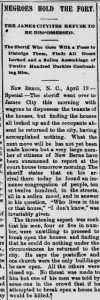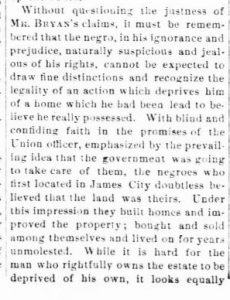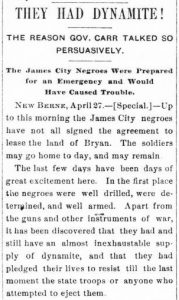James City, North Carolina is an unincorporated town near New Bern in Craven County. It has a tumultuous but little-known history that can be seen through historic newspapers on Chronicling America.
The history of James City began in 1862, when New Bern was occupied by Union troops in the Civil War. Union officials established a settlement across the Trent River for former slaves who had nowhere else to go. This settlement was named James City after Reverend Horace James, an Army chaplain who was the town’s leader in its earliest years. He later became an agent for the Bureau of Freedmen, Refugees, and Abandoned Lands. The Union confiscated the land that James City was built on from its former owners.
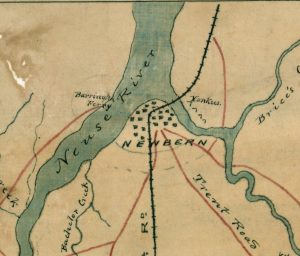
The city thrived for a few years, and became a haven for Black men and women in the years after the Civil War. Homes, farms, businesses, and churches were built and a local government was established. However, the residents of James City soon started facing setbacks. In the late 1860s, bad weather resulted in poor harvests. At the same time, the Freedmen’s Bureau began scaling back its financial support of the town. Lastly, in 1867, the federal government returned the land that James City was built on to the family of its former owner. Land that the town residents owned themselves was now owned by James Bryan.

These setbacks were disastrous for many of the town’s residents. The population shrunk from 3,000 residents to only 1,100 by the 1880s as people left due to the worsening economic conditions. Those who didn’t leave were forced to either pay rent to Bryan or work as sharecroppers.
The situation escalated in the 1890s, when Bryan began raising rents with the purpose of evicting residents who were unable to pay. Many residents objected, arguing that the land had been given to them originally, and they shouldn’t have to pay rent. Some residents argued that they should be compensated for the improvements they had made to the land, such as the farms and homes they had built. The residents even raised $2,000 to buy the land from Bryan. Each of these efforts to save the town failed. In 1891, the Supreme Court of North Carolina ruled that the land definitively belonged to Bryan. 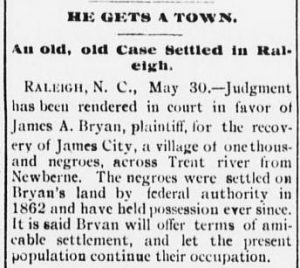
After this ruling, tensions in James City were running high. The town’s residents were furious and continued to refuse to pay rent. Newspapers reported on the potential for violence over this matter. The Craven County sheriff attempted to evict the residents but was unsuccessful. According to an article in the State Chronicle, the town residents peacefully resisted him by locking their doors, gathering on the streets, and refusing to answer the sheriff’s questions.
In April 1893, the First Regiment of the State Guard was ordered to James City to restore order and enforce the law—in short, to force the residents to pay the rent that Bryan demanded. This action was ordered by Governor Elias Carr.
Once the Carr and the state military got involved, the townspeople agreed to Bryan’s terms: rent ranging from 50 cents to $1 for three years. This agreement was reached without violence or significant bloodshed (one officer was killed when he fell off his horse). The residents that were unable to pay were forced to move. In the end, only 700 James City residents were able to remain in their homes.
Newspaper coverage of this event was extensive. Much of the news was informed by racist stereotypes and assumptions about the legality of the Black residents’ claims. Bryan’s demands were characterized as reasonable by the newspapers of the day. In contrast, the Black residents were portrayed as violent lawbreakers, or else as gullible and ignorant. This story is an interesting illustration of the racial dynamics of the Reconstruction era.
View full newspaper pages on Chronicling America:
https://chroniclingamerica.loc.gov/lccn/sn92072978/1893-04-25/ed-1/seq-1/
https://chroniclingamerica.loc.gov/lccn/sn91068076/1891-05-30/ed-1/seq-1/
https://chroniclingamerica.loc.gov/lccn/sn92072978/1893-04-20/ed-1/seq-1/
https://chroniclingamerica.loc.gov/lccn/sn91068245/1893-04-27/ed-1/seq-2/
https://chroniclingamerica.loc.gov/lccn/sn91068305/1893-04-24/ed-1/seq-2/
https://chroniclingamerica.loc.gov/lccn/sn91068305/1893-04-27/ed-1/seq-1/
Other resources:
Karin Lorene Zipf, NCPedia: https://www.ncpedia.org/james-city
Jonathan Martin, North Carolina History Project: https://northcarolinahistory.org/encyclopedia/james-city/


